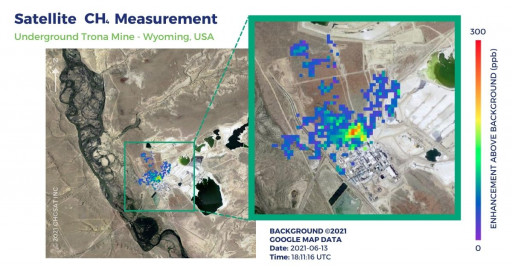
GHGSat Satellite Measurement
Underground Trona Mine - Wyoming, USA
MONTREAL - August 26, 2021 - (Newswire.com)
On June 13, 2021, GHGSat has captured the first-ever satellite observation of methane emissions from trona mining activities, with a spatial resolution of ~25m.
In a world-first, a GHGSat commercial satellite has detected a methane emission from the trona mining area of Green River Basin, Wyoming - the location of the world's largest natural deposit.
Trona is a sodium carbonate compound extracted from underground mines and processed into soda ash. Predominantly used to manufacture glass for the automotive and construction industries, it is also the raw material for baking soda (sodium bicarbonate), laundry, and cleaning products, and used in the manufacture of cloth and paper. It is the fracturing of the rock to extract the ore that releases methane, which must be vented from the mine for safety reasons. While soda ash can be manufactured synthetically, about 35% [ref] of the world's supply comes from natural sources.
GHGSat satellite technology detected and measured the methane emission with an estimated rate of nearly 950kg/h. Whilst smaller than the average emission rate from coal mines observed by GHGSat satellites over the last six months, at a continuous rate if captured and processed into natural gas, the emission level measured could supply electricity for a year to approximately 1M homes.
The volume of methane measured presents a potential opportunity for mining operators in setting up an investment structure, by converting methane emissions into renewable energy.
18.1 million tons of trona were mined from the Green River Basin area in 2019, with the region's mines supplying around 90% of the soda ash used in the United States. According to Wyoming Mining, the U.S Geological Survey estimated (in 1997) the total U.S. reserve of trona to be 127 billion tons, [ref] with about 40 billion tons recoverable for use. The next largest natural trona reserve (around 873 million tonnes) [ref] is located in Turkey with Botswana, China, Ethiopia, and Kenya also producing soda ash from natural sources [ref].
Both the UN Global Methane Assessment 2021 and the recent IPCC Climate Report have highlighted the rapid increase in methane emissions in recent years - with scientists attributing between 30% and 50% of the current rise in global temperatures to this potent greenhouse gas. Reducing methane is now one of the quickest actions we can take to curb global warming.
Coal mining accounts for around 11% of global methane emissions and closed pits still leak greenhouse gas. GHGSat high-resolution satellite technology can identify and measure new methane emissions around the world every day, even small emissions, from a single mine vent. This first trona mine satellite observation has prompted GHGSat to monitor these sources of methane to help industry and governments understand their emissions. As operators are trying to find new ways to reduce their emissions, reliable and accurate data becomes increasingly critical to reach their carbon-intensity targets.
For further information, please contact Sevana Jinbachian at sjinbach@ghgsat.com.
About GHGSat
GHGSAT is a leader in high-resolution greenhouse gas monitoring from space, providing actionable emission data to businesses, governments, and regulators worldwide. With proprietary remote-sensing capabilities and patented technology, GHGSat can monitor individual facilities, offering greater data accuracy and facilitating timely strategic decision-making insights. www.ghgsat.com
Press Release Service by Newswire.com
Original Source: First-Ever Satellite Capture of Methane Emissions From Trona Mining
